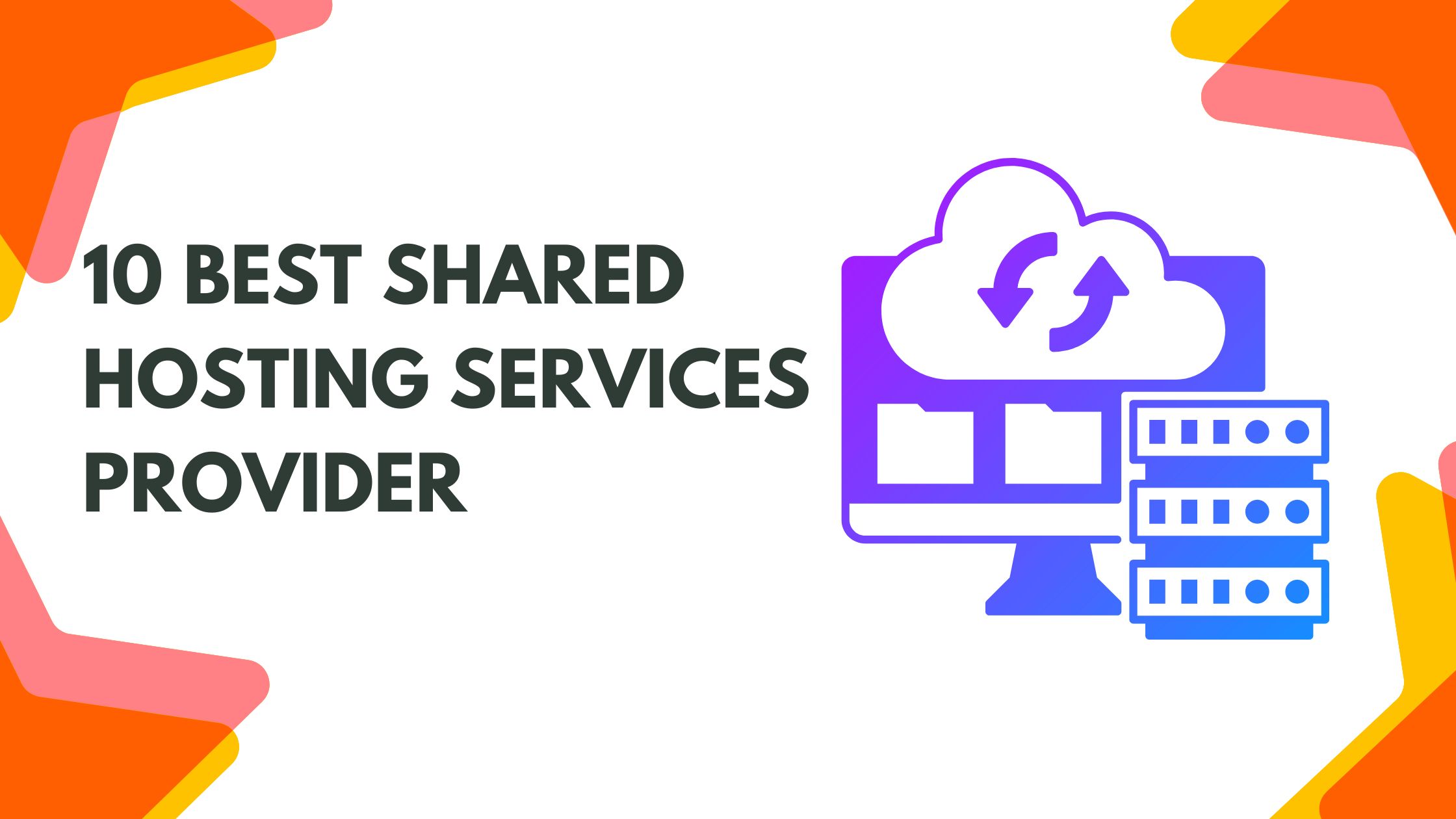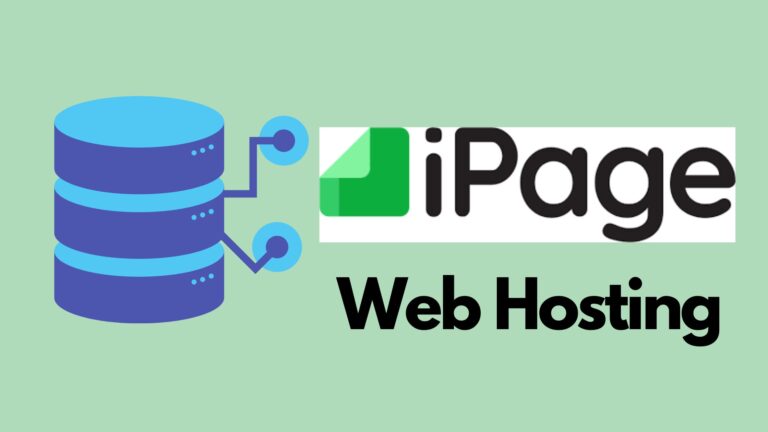Hosting is best thought of as leasing. A provider leases out the resources of its server. You can use those to power a website. Meanwhile, the provider takes care of all the pesky server maintenance so you don’t have to.
You might think an entire server would be too much for a single website—and, in many cases, you’d be right. This is where shared hosting comes in. A provider can let tens or even hundreds of users share a single server.
Users can draw from the same pool of server resources or each user can be allocated a certain amount. This is up to the provider, though the best shared hosting guide providers tend to prefer the latter.
Either way, it’s an effective arrangement. Shared hosting has made website ownership available to anyone, not just those who can afford their own server.
Here is the list of things to check into hosting.
- Background check – Starting out with as much info as possible is always a plus. We checked the reputation of a number of the established web hosting companies, both according to experts and users. Plus, we checked out website navigation, hosting plans, and discussed the details with sales support.
- Starting out – The next step was to purchase a plan with each provider, publish a basic WordPress site, and hook it up to a variety of monitoring tools.
- Testing the features – A provider typically provides a feature list. What the list doesn’t tell you is how effective the features are. We had to check if each one works as intended.
- Uptime – This is probably the most critical metric. Uptime is the percentage of time a website is available. We monitored it over a full year to get the most accurate projection of each host’s uptime.
- Speed – You need fast hosting to have a fast website. We used several tools (like Pingdom and Load Impact) to see how fast the servers are and how they handle high traffic.
- Support – Competent support is a telltale sign of a top-notch shared hosting provider. We contacted the support teams dozens of times with a variety of issues – some simple, some not so much. The best support has to continually perform well.
- Terms of service – ToS is a contract like any other. Unscrupulous companies can sneak in seemingly innocent, but misleading wording. If any clause raised a red flag, we found out what lay behind it.
- User experience – More viewpoints always add to a more accurate picture. This is why we interviewed a number of experienced users. Sometimes they could point out new issues with their company of choice. We went back and checked if the issues were legitimate and if they persisted.
We took all that data and condensed it to shape the most objective shared hosting reviews you’ll find. Keep reading to find out who the are the providers that offer great web hosting.
10 Best Shared Hosting Services
1. SiteGround

Best for: Users looking for a variety of proprietary features.
SiteGround was founded in 2004. The word about its services has since spread all over the world. Right now, it is approaching two million users with no indication of slowing down. Moreover, it is one of the most praised providers on the Web.
Let’s see what all the fuss is about.
Uptime
SiteGround has developed several technologies that ensure site integrity.
For one, it uses a tweaked version of Linux Containers to isolate shared hosting accounts. In layman’s terms, your website is separated from the rest of the server. Your site’s speed and security are ensured regardless of what other users do.
SiteGround backs this up with a 99.9% uptime guarantee. If it breaches it, you get a free month of hosting.
SiteGround’s uptime for the past year has been well over 99.99%. You can expect this from one of the best web hosts out there.
It also has one of the best server infrastructures in the business, and it shows.
Speed
Speed is just as important as uptime.
SiteGround’s servers take on average 0.42 seconds to respond. The time to fully load basic WordPress installation averages 0.96 seconds.
This is relatively quick, though a few shared hosting providers are a bit faster.
Where SiteGround really shines, though, is handling simultaneous users. Sending 50 virtual users to the server barely influenced response time.
All in all, SiteGround is among the leading hosts under load. If you have a demanding site and expect lots of traffic, your site will remain fast.
The service’s performance is worthy of the top web hosting company.
Support
SiteGround has one of the most comprehensive knowledge bases out there.
Beyond the general guides, you get dedicated tutorials for WordPress, Magento, Joomla, and Drupal. You can also download a free ebook on optimizing WordPress.
You’d be hard-pressed to find better-trained or more professional support with other shared hosting providers.
Features
SiteGround covers the basics well. Here’s what you get:
- SSD storage
- A free SSL certificate
- Daily backups
- Cloudflare CDN
- 1-click installations
You also get some top-notch security features in the game. These include a custom firewall and an AI Anti-Bot system. Combine that with strong redundancy and SiteGround’s servers are some of the safest out there – perfect if you want to stay safe from cyber attacks.
SiteGround is also one of the official WordPress hosts, along with BlueHost and DreamHost. As such, it offers insanely useful WordPress features. You get things like a WordPress staging environment and a robust custom caching tool.
The WordPress-optimized plans offer fantastic performance. If you’re a WordPress junkie, SiteGround is likely the best hosting service for you.
The more expensive plans also offer one free website migration.
WordPress users can use a custom plugin for unlimited migrations. The plugin migrations will likely require troubleshooting. Still, it’s better than performing the whole migration manually.
SiteGround doesn’t state mention, but you get a free WildCard SSL certificate with all plans. You can easily protect all of your subdomains, which goes a long way in ensuring ecommerce safety.
Finally, SiteGround has recently implemented a custom control panel. The new panel has all the functionality of a cPanel, so users can switch from one panel to the other without much trouble.
The most significant change is in the layout. SiteGround redesigned the cPanel’s structure to make navigation dramatically easier. Since you get cPanel’s functionality, this is a fantastic solution.
You’ve probably already noticed the features often have the phrase “best in the business” attached to them. In this particular case, it’s true—SiteGround truly has one of the top shared hosting offers.
Pricing
SiteGround offers three shared plans:
StartUp—Starts at $3.95/month, $11.95/month to renew
GrowBig—Starts at $5.95/month, $19.95/month to renew
GoGeek—Starts at $11.95/month, $34.95/month to renew
The plans are fully WordPress-optimized so there are no separate WordPress solutions.
The StartUp plan lets you create one website. It comes with 10Gb of storage and is suitable for about 10,000 unique monthly visitors. The resources are more than enough for an effective start.
The GrowBig plan lifts the website limit. It also increases the resources to 20Gb of storage and 25,000 visitors.
GoGeek offers 30Gb of storage and accommodates 100,000 visitors.
If you plan to run one website, the usage limits are perfect. However, if you have several large sites, your resource pool can get depleted fairly quickly.
One nasty surprise is that SiteGround charges you a $14.95 setup fee if you purchase the plan for one month. Most users go for a one-year plan anyway, but this makes SiteGround expensive to try out.
Otherwise, it’s a fantastic offer through and through. The features justify the price and then some.
The competition is tough, but SiteGound makes a strong case for providing the leading shared hosting service out there.
2. Hostinger

Best for New users to hosting providers.
Hostinger is one of the independent hosting providers that made it big.
For many companies, it can be tough to keep up just a few thousand clients. Hostinger, on the other hand, has 29 million to work with.
Let’s see if it rises to the task.
Uptime
Hostinger’s uptime averages at 99.91%. This amounts to about 39 minutes of downtime per month, which is decent.
This fluctuates month-to-month. It stays at 99.99% in most months.
Hostinger does offer a 99.9% uptime guarantee. If it falls below this mark, you get 5% of your monthly hosting fee.
Most web hosting reviews are under the misconception you get this as a refund. Instead, the terms of service state you get credit to purchase Hostinger services.
In practice, this wouldn’t really work. 5% of the basic plan equals four cents of credit—too little to get anything.
This is why Hostinger gives you a few days to a week of free hosting instead. The offer helps the company hold itself accountable.
All in all, uptime is reasonable, though the December outage is worth noting.
Speed
Hostinger sports a 0.23-second average response time. This is among the fastest front ends in shared hosting.
It takes 0.81 seconds to fully load a basic WordPress page. In contrast, some servers take this long just to respond. It’s fantastic if you want to maximize your website speed.
Admittedly, the backend struggles with high traffic a little. Hostinger lags just a bit behind the top providers.
In short, Hostinger has one of the fastest shared hosting services, although the backend could stand a little improvement.
Support
Hostinger’s support is available 24/7 through chat and email. Admittedly, though, the lack of phone support is not ideal.
Otherwise, the support agents are among the better-trained in the business.
Hostinger ensures each agent can answer all types of queries. This way, support rarely has to transfer you to another agent or to higher-level support. It’s fantastic that the provider found a way to get rid of one of the most annoying practices in hosting.
The support is also eager to help beginners. The agents do their best to break down each situation so you can avoid having the same issue twice. It’s an amazing learning experience.
The beginner-friendly experience, in part, explains how Hostinger attracts so many users. It’s definitely one of the top hosting companies for first-time website owners.
Features
You get SSD storage, a website builder, 1-click installs, powerful Nginx caching, and more.
Hostinger offers either an SSL certificate or a domain name when signing up. You’ll need to buy the other one, but the prices are similar, so you can go with either.
Only the most expensive plan comes with daily backups. You get weekly ones otherwise. Weekly backups are fine for most users, but a few providers have an advantage here.
All plans come with Git, and all but the smallest plan offer unlimited cron jobs. Both are cool features that can come in useful.
Hostinger has a custom control panel – hPanel, as they call it, that is easy to use and intuitive. Unfortunately, it lacks cPanel’s developer tools.
In essence, hPanel is a spectacular solution for easing yourself into website hosting. If you have experience with cPanel, though, it takes a bit of getting used to.
Hostinger has a comprehensive offer. You get all the essential features for starting a website, plus it’s beginner-friendly.
Pricing
Hostinger offers three shared hosting plans, starting at $0.99/month, $2.59/month, and $4.49/month. This is as affordable as shared hosting services get.
The catch is that you have to purchase four years of hosting to get these prices. Still, $47.52 for four years is ridiculously cheap.
Hostinger is one of the hosts that rely on increasing the renewal price. The cost of hosting after the first four years goes up to $9.59/month, $14.49/month, and $19.99/month.
The renewal fees are higher than average. Still, after four years, your website will probably be making enough to cover the hosting costs.
The starter plan lets you create one website with 10Gb of storage and 100Gb of bandwidth. This is more than enough to run a new website for a while.
The other plans let you create unlimited websites. The storage is 20Gb and 30Gb, and bandwidth is unlimited.
Hostinger is unclear on the fair use policy, so it’s difficult to tell what “unlimited” actually means. Still, the resources tend to be enough to run a few decent-sized websites.
The plans are generous, especially considering you get plenty of quality features. If you’re looking for the a great shared hosting deal, few hosts are as budget-friendly as Hostinger.
3. GreenGeeks

Best for: Ecommerce websites.
Geeky and environmentally friendly – it’s obvious those are GreenGeek’s main selling points. It promises a robust hosting service with 300% carbon offsetting.
Now, green hosting is awesome, but as consumers, we are more interested in that “robust hosting” thing. Which is why I took GreenGeeks for a spin.
Uptime
GreenGeeks’ special features ensure your website remains available. It has account isolation, power redundancy, Raid-10 arrays, and proactive server monitoring.
In essence, you’ve got protection against both digital and real-world problems.
GreenGeeks has a 99.9% uptime guarantee. However, the company couldn’t provide any logs to prove it monitors availability.
Moreover, it doesn’t mention any refund if it does breach the guarantee. As things stand, it’s more of an uptime promise.
GreenGeeks does keep the promise, though. My monitoring tool recorded a great shared hosting uptime – 99.99%. Enough said.
Speed
Let’s preface this by pointing out I got odd results when I attempted to test GreenGeeks’ backend. Sending over 25 virtual users makes response times spike abnormally.
The same happened with InterServer, so it’s not an isolated case. The most likely scenario is some security tool is interfering with the testing. I have not been able to confirm this yet, though.
Still, there was no way to get reliable data on the backend.
As for the frontend, GreenGeeks’ robust infrastructure shows here as well.
The server takes 0.29 seconds to respond, which is extremely fast. Load times are quick too—0.86 seconds. GreenGeeks’ frontend speed is in the same league with the best hosting companies.
Support
The knowledge base has an enormous range of articles. Both beginners and experienced users will find something useful.
The support team is courteous and answers all questions quickly. This is a positive sign. It indicates the agents know what they’re doing instead of just following a script.
With that said, it does take a bit of back and forth to get to the bottom of more complicated issues.
The support is above average, but a couple of providers handle it better.
Features
GreenGeeks offers SSD storage, Cloudflare CDN, cPanel, a free domain name, and much more.
You also get a website transfer, a WildCard SSL, and nightly backups—few providers offer all three for free.
GreenGeeks strives to create an environment for ecommerce. That’s why you get 1-click installs for some of the most popular shopping carts out there.
A proprietary caching tool comes with the two more expensive plans. It’s useful for handling demanding websites.
The only upsell is domain privacy, which costs $0.83/month. Domain privacy is useful, but extremely few companies offer it for free, so this is not a huge surprise.
The features are excellent. It’s particularly attractive that GreenGeeks offers almost everything out of the box. Even some of the best hosting sites rely on upsells, which gives the whole industry a bad name. It’s nice to see GreenGeeks treats its customers with respect.
Pricing
GreenGeeks has three plans:
Lite—Starts at $2.95/month, $9.95/month to renew
Pro—Starts at $5.95/month, $14.95/month to renew
Premium—Starts at $11.95/month, $24.95/month to renew
The Lite plan just limits you to one website. All plans come with unlimited bandwidth and storage.
The Pro and Premium plans also increase processing power, memory, and file limit. This is fantastic for maintaining high speeds as your website grows.
You get a 30-day money-back guarantee. Unfortunately, GreenGeeks also deducts a $15 setup fee if you use the guarantee.
You’ll notice GreenGeeks has a similar offer to SiteGround.
Your best bet is to use GreenGeeks for hosting an online store. The higher resource caps and the features are better suited for demanding ecommerce websites.
For other website types, SiteGround performs better.
Nevertheless, both companies offer some of the best web hosting in 2021. You’ll get excellent service either way.
4. BlueHost

Best for: WordPress websites.
Since its inception, BlueHost has been one of the fastest-growing hosts. It got acquired by EIG, which caused a few hiccups, but it has managed to get things back on track.
Today, BlueHost manages over 2 million accounts and is officially backed by WordPress. Its credentials are undeniably impressive, but let’s dig into its offer and see what it can do for you.
Uptime
Several shared hosting reviews out there claim BlueHost’s plans run on outdated technology. In actuality, BlueHost has recently overhauled its infrastructure. Now, it has some top-notch machines.
The uptime shows this. It averages at 99.98%, which is well above the industry standard. The percentage fluctuates a bit monthly but stays above 99.9%.
There is no uptime guarantee, though, which is odd.
The support assured me BlueHost gives adequate compensation in case of an outage. Without an official policy, though, this seems more like optimism on the agent’s part.
Nevertheless, uptime has been stable for well over a year.
Speed
The infrastructure upgrade shows in the speed as well.
With 0.37 seconds to respond and 0.96 seconds to fully load a WordPress page, BlueHost is consistently the fourth fastest hosting provider.
Admittedly, fourth place doesn’t have the same ring to it as first or second. However, the top performers are only milliseconds faster, and competing with the best website hosting providers is nothing to scoff at. BlueHost is still lightning-fast.
BlueHost’s servers are also tough enough to handle resource-hungry websites. The difference when loading under high traffic is barely noticeable.
This comes in handy, as the plans come with some interesting ecommerce features.
Support
Support is courteous, competent, and industrious. The agents really went the extra mile in answering my questions. They worked out even complicated problems without passing me to higher-level support. It’s truly outstanding service.
EIG-owned providers often get criticized for inadequate support. It’s nice to see BlueHost break the stereotype.
The only complaint is it sometimes takes a minute or two to get connected through live chat. It’s a small issue, though—definitely not anything that could jeopardize BlueHost’s standing as one of the best web hosts.
The knowledge base is also respectable. You get plenty of video tutorials—perfect for beginners.
Features
BlueHost’s feature list also got a recent update. It now includes:
- An SSL certificate
- SSD storage
- A free domain name
- Cloudflare CDN
- Fantastic security features
You also get a few cool freebies. These include a free trial for Office 365 Mailbox. Paying for $25 of Google or Microsoft ads gets you $100 extra credits.
Most providers reserve daily backups for the more expensive plans, but BlueHost offers them across the board.
You get cPanel, which is the industry standard. This is probably the best control panel solution, and you’ll see more providers in these website hosting reviews using it.
BlueHost is also a supporter of open-source and contributes to 80+ open-source projects. Its hosting plans are, naturally, optimized for running any of them. If you like WordPress, Joomla, or Drupal, you get useful custom features and much faster load times.
Unfortunately, site migrations are paid. They cost $144.99, which is ridiculously expensive. If you’re not confident in doing it yourself, one of the providers with free migrations might provide better value.
Otherwise, BlueHost’s features are fantastic. This is one of the most comprehensive offers, even compared to top hosting companies.
Pricing
There are four shared plans. The pricing goes as follows:
Basic—Starts at $2.95, $7.99/month to renew
Plus—Starts at $5.45, $10.99/month to renew
Choice Plus—Starts at $5.45, $14.99/month to renew
Pro—Starts at $13.95/month, $23.99/month to renew
Here’s what each plan has in store:
- The Basic plan lets you create one website. You get 50Gb of storage, which is generous for a starter website, unlimited bandwidth, and 25 subdomains.
- The Plus and Choice Plus plans lift the storage, domain, and subdomain limits and add spam protection. The only difference is Choice Plus comes with domain privacy and CodeGuard site backups.
- The Pro plan adds a dedicated IP address and stores sites on a server with fewer users. This means you get more server resources, letting you handle more traffic. You can also purchase a WildCard SSL certificate, which comes in handy in handling ecommerce security.
Remember when I mentioned the strong backend? Ecommerce websites tend to be resource-hungry, so BlueHost’s infrastructure is perfect for making everything run smoothly.
Speaking of ecommerce, BlueHost also offers special WooCommerce-optimized shared plans. These come with increased storage and a few more useful features.
If you’re looking for a shared hosting provider for ecommerce, BlueHost has a unique and robust offer.
WordPress users can easily scale into managed WordPress hosting. This is more expensive than the standard shared hosting, but it comes with fantastic custom features. It’s an entirely different WordPress experience.
The only disadvantage of BlueHost is you can’t pay month-to-month. This is usually fine, though. It’s almost always better to go for a long-term plan and take advantage of lower starting fees.
Bottom line: BlueHost has some of the top shared hosting plans for ecommerce, along with A2 Hosting. Plus, it’s one of the top choices for CMS like WordPress.
5. DreamHost

Best for: Users looking for a reliable shared hosting provider.
DreamHost is your friendly neighborhood hosting company. It is proud of its contribution to open-source and green energy, and even more so of the hosting service it provides.
Be that as it may, would-be customers are more interested in concrete features. Let’s see what DreamHost does to provide a satisfying hosting experience.
Uptime
DreamHost has a 100% uptime guarantee, which is tough to beat.
Now, 100% uptime would be unrealistic even with AWS, let alone shared server hosting. DreamHost’s terms of service offer clarification.
The deal is any downtime gets you a day of free hosting. If you have over one hour of total downtime, each additional hour adds another free day.
As far as uptime guarantees go, this is one of the better ones. It helps DreamHost maintain a certain standard of service.
And DreamHost delivers. It has maintained perfect uptime throughout the testing period.
Speed
As for speed, servers take 0.28 seconds to respond and 0.92 seconds to load a page. Both results peg it as the third fastest hosting provider—mere hundredths of a second behind the first place.
Where DreamHost amazes is in handling high traffic loads. Nearly 300 simultaneous requests caused no detectable difference in load times.
Many providers, who are fast out of the box; stumble under load. Looking at the overall performance, DreamHost is the fastest shared hosting provider.
Support
The knowledge base is extensive, covering everything from hosting basics to the specifics of database management.
In addition, DreamHost is the third official WordPress host. As such, it has among the most extensive WordPress knowledge bases out there.
The support agents are real experts in Linux shared web hosting and WordPress. They were helpful and informative any time I had a problem.
Many users complain tech support is not actually available 24/7.
Indeed, live chat only works 16h a day and there’s no phone support.
This is a huge problem. Issues can occur at any time of the day (or night). The support might be fantastic, but you need it 24/7.
Features
You get a host of features including SSD storage, SSL certificate, domain name, daily backups, domain privacy, and much more.
DreamHost has a proprietary control panel.
The control panel is a user-friendly solution, though cPanel would be slightly more convenient. Best domain hosting services usually use cPanel. Most proprietary control panels just make things more difficult for users already familiar with cPanel
DreamHost doesn’t offer migrations, making it less than ideal if you already have a website. The only option is to pay $99 for a WordPress website transfer. Otherwise, you have to do it yourself, which is even more of a challenge with the custom panel.
Another thing to keep in mind is that an email inbox comes with a small fee of $1.67/month with the starter plan. It’s odd since practically everything else is a freebie, but it’s just how DreamHost runs its service.
Other than that, the features are fantastic, especially for WordPress users.
Pricing
DreamHost only has two shared hosting plans.
The Starter plan costs $2.59/month.
The Unlimited plan is $5.95/month, if you make a three-year commitment.
DreamHost is one of the few providers that don’t increase prices on renewal. If you commit for three more years, the cost stays at $2.59/month.
These are the most pocket-friendly shared hosting plans if you’re looking for a long-term bargain.
DreamHost also has a 97-day money-back policy. It’s the longest in the business and leaves you more than enough time to test everything out.
Both plans come with unmetered bandwidth.
The Starter plan limits you to one website with five subdomains and 50Gb of storage. The storage amount is generous, although the subdomain limit can be restrictive for some users.
If you need fewer than five subdomains, though, you can stay on the starter plan for quite some time.
All in all, this is one fantastic deal. DreamHost could easily be the leading shared hosting company, but the lack of 24/7 support drives the value down a bit.
6. A2 Hosting

Best for: Users looking for an extensive speed optimization features.
A2 Hosting is an independent provider based in Ann Arbor. It not only makes huge investments into hosting technology but also does its part in preserving the environment.
It’s always nice to find a company with a positive culture, but it takes more than that to get named one of the best website hosting sites. Here’s what the numbers say about A2 Hosting.
Uptime
A2 Hosting has the usual 99.9% uptime guarantee. If it gets breached, you get 5% of your monthly hosting fee back. This is more or less the standard guarantee for the industry.
The actual uptime surpasses 99.99%, though. It is a reliable indicator of excellent infrastructure.
That’s all there is to say. If you go with A2 Hosting, your yearly downtime will be measured in minutes.
Speed
A2 Hosting is loud about its speeds. If you go to its homepage, you immediately get hit with an “Up to 20X Faster Web Hosting” banner.
The servers take 0.54 seconds to respond and 1.15 seconds to load a page. This is above-average speed, but, let’s face it—A2 would need improvement to outperform providers like Hostinger.
Note that this is the performance with all the optimization switched off. A2 Hosting offers more speed optimization tools than other providers. You’ll have an easy time maintaining fast speeds as your site grows.
A2 Hosting’s default speed is respectable. What’s even better the extra optimization makes A2 one of the best website hosts for handling demanding sites.
Support
Independent providers tend to have an advantage here. A smaller user base leaves them more space to run the support department the way they want.
A2 Hosting opts for a more direct approach. The agents often prefer to go in and fix the issue without trying to get you to solve it yourself.
On one hand, this is a huge advantage if you just want a problem solved quickly (and who doesn’t?)
On the other, DIY users may prefer a support team that goes for a more cooperative approach. If you’re one of them, one of the other shared web hosting reviews here likely has more suitable providers.
You can reach the support through live chat, email, phone, and Skype call—the latter being unusual, but a convenient channel.
A2 Hosting also has a respectable collection of in-depth articles on various topics. DIY users love it.
Features
A2 Hosting offers features like SSD storage, automated backups, robust security, and more.
You also get plenty of freebies like a WildCard SSL certificate, ad credits, HackScan security, a free site migration, etc.
You also get a proprietary WordPress plugin called A2 Optimized. It works like a charm in helping enhance WordPress performance and security.
One issue is A2 Hosting advertises a bunch of features as available. It then only offers them as upsells or throws them into the most expensive plan. Cloudflare CDN, Railgun optimizer, and the much-advertised 20X Turbo boost are all extra.
The additional features are fantastic if you need to accommodate a demanding website and have money to spare. For example, they are perfect for establishing a strong online store.
If you’re looking for a budget-friendly solution, though, you might want to take a look at a few other hosts. Plenty of other domain hosting services have more suitable plans.
Pricing
A2 Hosting has three shared plans:
Lite—Starts at $3.92/month, $7.99/month to renew
Swift—Starts at $4.90/month, $9.99/month to renew
Turbo—Starts at $9.81/month, $18.99/month to renew
The plans vastly differ in features. I recommend checking out the full feature list before picking one.
While all plans have unlimited storage and bandwidth, the Lite plan caps you at one website and five databases. The database limit makes $3.92/month steep for the features you get.
The more expensive plans, on the other hand, are reasonably priced. The Turbo plan, in particular, is well worth the money. It has fantastic features for highly demanding websites.
To summarize, A2 Hosting is among the best website hosts if you need a cutting-edge solution for a demanding site. One of the other hosts would be a more cost-effective option for most users, though.
7. InMotion Hosting
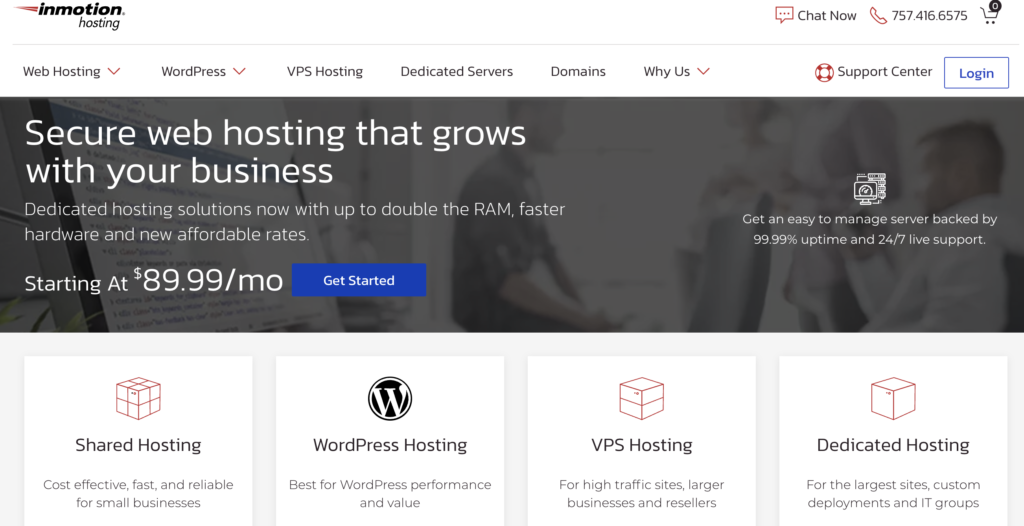
Best for: Compact site for the American market.
InMotion Hosting is an independent hosting provider. Compared to the giants like EIG and GoDaddy, it’s the little guy—if you can call a host with 350,000 domains “little.”
Be that as it may, the giants can often learn a thing or two from the underdog. Let’s see what InMotion Hosting has to teach them.
Uptime
InMotion Hosting used to offer a 99.99% uptime guarantee. This looked great on paper, but maintaining such uptime month-to-month is unrealistic even for the best web hosting services.
InMotion has since toned down the overzealous offer and now gives a 99.9% guarantee like most providers.
If the company breaches it, you get compensated for the time the server was down. So, if you have 2% downtime, you get 2% of the monthly fee back. The offer does the job, but most providers offer more.
InMotion Hosting maintains an average uptime of 99.95%. This fluctuates a bit, but it stays above the 99.9% industry standard.
Speed
With 0.64 seconds to respond and 1.28 seconds to fully load a page, InMotion Hosting is right in the middle. It’s fast enough for everything to run smoothly, but lags behind the top shared hosting companies.
Note that InMotion Hosting has one server farm on the East Coast and one on the West Coast of the U.S. This means you’ll get the best speeds in North America.
That being said, it uses a technology called Max Speed Zones. The deal is InMotion Hosting has partnered up with a bunch of ISPs and peering exchanges. This way, speeds all over the world are much higher than they’d be otherwise.
In theory, this should provide the same load times regardless of the user’s geographical location.
In practice, it sort of works and sort of doesn’t. Granted, InMotion delivers data at impressive speeds. Still, hosts with servers in, let’s say, Amsterdam, perform much faster in Europe.
InMotion Hosting is fast if you target an American audience. If you do have a few outliers around the globe, though, you’ll be able to handle them as well.
If you’re looking to target European or Asian audience, though, other providers in these shared hosting reviews would probably make a better match.
Support
InMotion Hosting probably has the most comprehensive knowledge base out there. It contains a massive collection of articles, guides, and video tutorials.
On top of that, the active community often starts discussions in the comments. That way, each guide branches out into solutions for dozens of problems. If you love the feeling of a tightly knit community, InMotion has a fantastic one.
The support team is available through phone, live chat, email ticket, and Skype call.
One benefit of a smaller client base is that support can dedicate more time to each user. The agents took the time to understand each problem I had and guide me through solving it.
I have only nice things to say about InMotion’s support—it does an excellent job of solving your issues.
Features
Here’s what you get out of the box:
SSD storage
free SSL
decent security
efficient marketing tools
website migrations
A domain name
$150 of free advertising credits
If we made a web hosting comparison chart, you’d see most providers have between 60 and 80 1-click installs. In contrast, InMotion Hosting provides 400. This is most likely more than you’ll need, but it shows the company puts effort into the hosting service.
Automated backups are another useful feature. This service has limitations, though. It only works with sites under 10Gb. Also, only one site restore in four months is free. Each additional one costs $50.
The additional fee is annoying, but it’s affordable compared to what a few other providers charge. In general, it’s good practice to keep your own backups. It’s insurance in case you can’t use the automated one.
All plans come with BoldGrid, which is a unique WordPress solution. It’s a lean, robust website builder that enriches WordPress with pre-built themes and a drag-and-drop editor. Both experienced users and newcomers will enjoy the overhaul of the WordPress experience.
In the feature department, InMotion Hosting can go toe to toe with the top shared hosting providers. It’s an outstanding offer.
Pricing
Three shared plans are available:
Launch—starts at $3.99/month, $7.99/month to renew
Power—starts at $5.99/month, $9.99/month to renew
Pro—starts at $13.99/month, $15,99/month to renew
InMotion has a 90-day money-back policy—three times longer than standard. It’s great for dipping your toes into hosting.
The Launch plan lets you create two websites, while the other plans lift the limit. All plans also come with unlimited bandwidth and storage.
The company’s ToS leaves out the actual plan limits. I asked the support, but it only maintained the inode limit caps you at 50,000 files.
This might seem like a lot, but a few WordPress websites can exhaust it in a blink of an eye. In contrast, some providers cap you at 300,000, or even 500,000, files.
InMotion Hosting receives a few complaints about being forced to upgrade. Then again, so do all providers. Still, knowing the actual plan limits would allow for better planning.
In essence, InMotion Hosting is a fantastic choice if you’d like a compact site for the American market. If you’re looking for shared hosting for a huge, demanding site, though, you’re probably better off with a provider like A2 Hosting.
8. InterServer
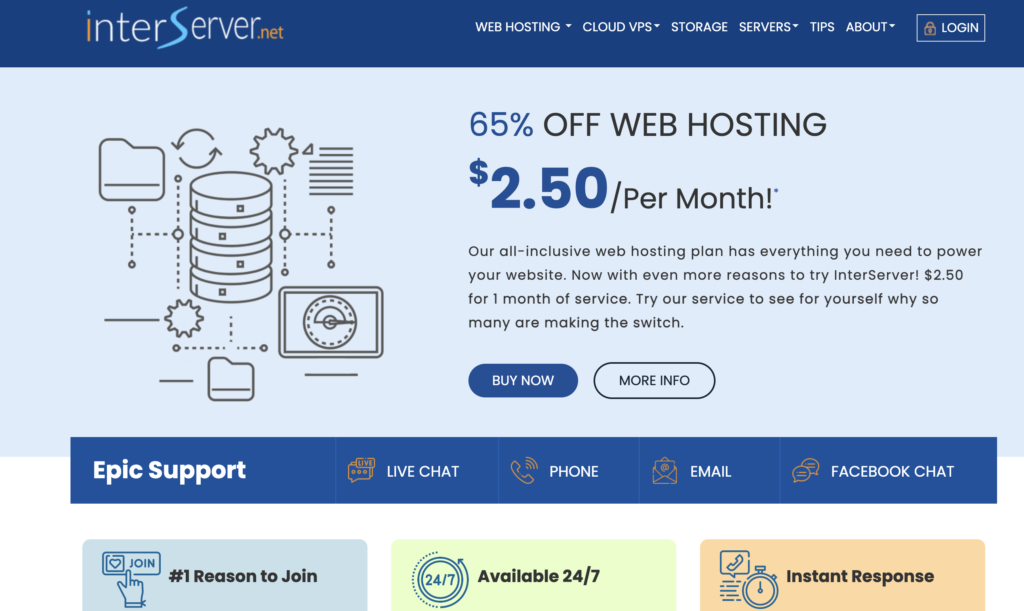
Best for: Users looking for a Linux-based hosting solution.
InterServer is an inspiration to new hosting providers. What started out as a reseller hosting account quickly grew into one of the most cutting-edge providers.
Unlike most growing web hosting companies, though, InterServer does not sacrifice quality for profit. Quite the opposite, it self-imposes a limit of 100 new hosting accounts per day.
Theoretically, this helps InterServer maintain a high standard of service without being overwhelmed. Let’s see how well it works in practice.
Uptime
InterServer offers the 99.9% industry-standard uptime guarantee. If uptime goes below this mark, you get credits in the value of up to 50% your monthly hosting fee.
The uptime averages around 99.95%. It amounts to about 20 minutes of downtime per month, which is decent.
The company’s reliable infrastructure results in expected quality.
Speed
InterServer only allocates resources until servers get to 50% capacity. If one user’s site outgrows the predicted resource limit, the server can support everyone until the user upgrades.
This, together with a robust infrastructure, leads to lightning-fast response times of 0.29 seconds and load times of 0.88 seconds. The speed is impressive, though InterServer needs to shave off about a tenth of a second to reach the top web hosting speeds.
Unfortunately, I wasn’t able to test the speeds under load.
Response time is stable until the website gets over 25 concurrent visitors. Any more and it rises abruptly. A similar problem occurred with A2 Hosting.
The other results are promising, though.
Support
Support is available 24/7 through the usual channels—phone, live chat, and email ticket. It’s best to use the phone if you can since live chat can be buggy.
One reason InterServer sets a limit on new clients is support. Newcomers usually need assistance, and this helps the support team dedicate enough time.
The support staff is helpful, but not as well-trained as that of the leading web hosting providers.
At least partly, support seems to have been outsourced overseas. Consequently, it takes more time for complicated issues to get resolved.
There’s no way to directly access the knowledge base. Instead, you can only access 6 different categories from the footer. From there, you have to click on “Tips” to see the others.
It’s nice InterServer keeps adding new articles, but the navigation is in desperate need of an overhaul.
Features
InterServer offers:
SSD storage
An SSL certificate
cPanel
Cloudflare CDN
Weekly backups
Raid 10 redundancy
Robust security
A domain name isn’t a freebie, but you can register one for $1.99—quite a deal.
Did you think InMotion Hosting’s 400 1-click installs were a lot? Well, InterServer goes even a tad further with its 461.
A common problem in shared server hosting is getting a server flagged as spammy. It’s enough for one user to send out spam, and suddenly the whole server can’t send emails.
InterServer solves this with spam checks and using a gateway server to send emails. It is unclear whether this is 100% foolproof, but none of the users has complained. It’s a cool feature few hosting companies offer.
All in all, the features are fairly high-end.
Note that I am reviewing InterServer’s Linux shared hosting. The company also offers Windows-based hosting with similar features at a comparable price.
Since A2 Hosting’s security trouble, InterServer has been the best Windows shared hosting option around. Definitely check it out if you want to run Windows-specific apps.
Pricing
InterServer offers only one plan. It costs $4/month with a three-year commitment.
As with DreamHost, the prices stay the same on renewal. All you have to do is prepay for another three years.
In fact, InterServer offers a price lock guarantee. This means the pricing stays the same even if you continue using the plan for a hundred years. Neat, right?
A common problem with one-size-fits-all solutions like this is scaling. It’s challenging to jump from shared hosting to a significantly more expensive VPS plan.
Luckily, InterServer’s cloud VPS plans start at $6/month. It’s a perfect scaling option once you outgrow shared hosting.
As for the shared plan, there’s no limit on storage, bandwidth, emails, domains, or databases. As with all “unlimited” offers, InterServer can force you to upgrade if you’re overspending server resources.
All in all, the plan is excellent. $4/month for multiple websites is in the top 10 web hosting deals out there.
9. HostGator

Best for: Users looking for a reliable and stable hosting provider.
HostGator started 17 years ago in a Florida dorm room. It has come a long way since its inception and is now among the largest web hosting companies.
Still, larger providers can struggle to maintain the same level of service as more compact companies. Let’s see how HostGator handles the challenge.
Uptime
Like BlueHost, HostGator’s acquisition by EIG was a bit bumpy. Luckily, like BlueHost, its datacenters have received an upgrade and have entirely recovered.
HostGator backs the integrity of its servers with a generous guarantee. If you have more than 0.1% of monthly downtime, you get a full month of hosting for free.
It doesn’t seem HostGator will have to worry about giving out free hosting, however. Its uptime has remained at 100% since August last year.
Speed
With 0.63 seconds to respond, HostGator’s servers are average. The response might seem fast, and it is, as far as shared hosting goes. Yet, at least a couple of other shared hosting providers respond twice or thrice as quickly.
HostGator takes on average 1.21 seconds to fully load a basic page. This is reasonable considering the response times.
Unfortunately, the servers struggle with high traffic. Getting 50 simultaneous visitors is enough to make the response times triple or even quadruple.
Bottom line – the server speed is fine. You can get reasonable load times, but you might need to upgrade your plan sooner than with other providers.
Support
It’s no secret large providers often have inadequate support. Training a support team that can service millions of users is no small task. It’s often tempting to outsource it to whoever is cheapest.
Fortunately, HostGator’s support is competent. It does an excellent job of handling all issues and helping beginners learn the ropes.
With that said, HostGator does struggle with its large client base. This results in support being slower than that of many other shared hosting services. Queries that could be resolved through chat sometimes get escalated to email support, and things drag out from there.
The support does fix your issues, but it can get frustrating to wait for help with simple matters.
Thankfully, HostGator’s knowledge base is extensive. It is frequently updated with helpful and beginner-friendly guides. If you enjoy a little DIY, you can get by without ever contacting support.
Features
You get SSD storage, an SSL certificate, cPanel, 1-click installs, and a website builder. In short – HostGator covers the basics.
As with BlueHost, spending $25 awards you extra $100 of Google AdWords and Bing Ad credits. It helps attract a few extra visitors early on.
You also get a website transfer free of charge. It’s quite an advantage over BlueHost’s $150 transfer.
Unfortunately, HostGator flaunts features like CodeGuard, SiteLock, and domain privacy as “available.” It advertises them as “website essentials,” but these are actually paid features—a bit misleading.
Other than that, there’s not much to talk about. HostGator covers the key features well, and the website migration is useful if you already have a site.
It’s enough for running a standard website. Still, HostGator lacks some features and doesn’t stand out among the top shared hosting providers.
Pricing
There are three plans:
Hatchling Plan – Starts at $2.75/month, $10.95/month to renew
Baby Plan – Starts at $3.95/month, $11.95/month to renew
Business Plan – Starts at $5.95/month, $16.95/month to renew
The Hatchling plan lets you create one domain with 100Gb of storage. 100Gb is more than generous for just one website.
Other plans offer unlimited domains and storage. All plans come with unlimited bandwidth.
HostGator does make it clear you must comply with the fair use policy and not abuse server resources.
Their Business plan also adds a dedicated IP address, a few SEO tools, and a free Positive SSL certificate – all features that are helpful with ecommerce.
All in all, the price is fair, though a few hosts are more affordable. Taking the features into consideration, you’re getting reliable hosting for an average price.
10. Scala Hosting
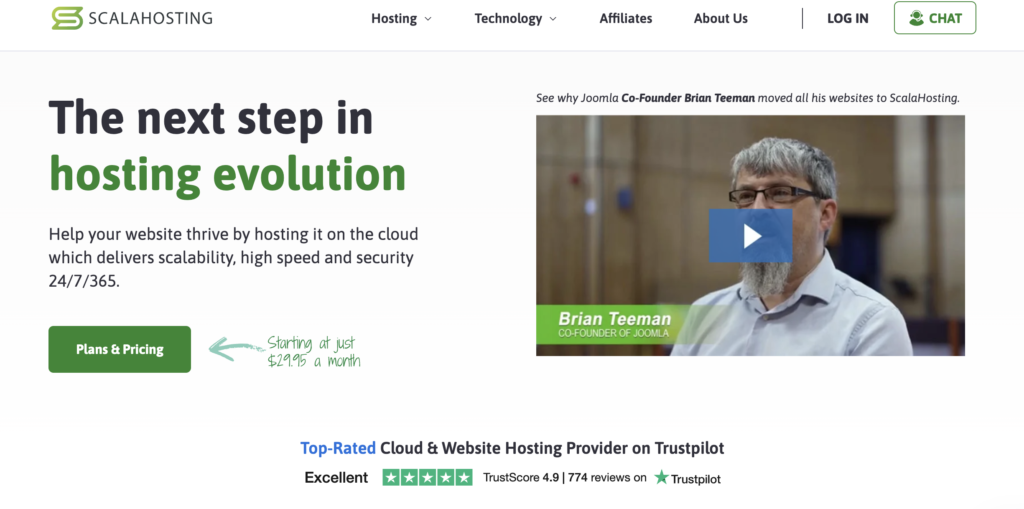
Best for: Hosting professional blogs.
Scala Hosting is one of the oldest shared hosting providers around. It first set up shop in 2007 as a VPS host for small businesses. The introduction of cloud computing, however, made the company switch to offering scalable services. As a result, its customers grew from 50,000 to 700,000 over a decade. That goes to show the level of trust consumers have for this vendor.
Let’s see if it will live up to the hype.
Uptime
Scala Hosting’s 99.90% uptime guarantee stands no chance against the likes of DreamHost. Data from Pingdom shows it hardly meets it. In reality, the figure averages around 99.85% for this shared hosting provider.
That means you should expect outages of 60 minutes or more monthly. You can make good use of the service level agreement if that happens. It says you stand to receive up to 100% credit.
Let’s dive a little deeper.
Speed
Scala is one of the fastest shared hosting vendors on the market. Its servers have a response time of approximately 0.25 seconds. Speed varies, however, depending on the location of your visitors.
North America and Europe are the fastest, with pings of 0.15 seconds. Asia and South America follow next with 0.20 seconds. Australia comes last – 0.27 seconds.
Here’s a pro tip:
You can speed things up using Scala Hosting’s free CDN service. It’s powered by Cloudflare that has over 200 edge locations globally. It will boost your website’s response time by 200% on average.
Support
Scala Hosting is among the best website hosts with excellent support services. You can seek help at any time of the day or night.
The available channels include live chat, email, and phone.
Its agents are not only super friendly but also patient. They will answer any questions you have without blubbering around.
We love the way they transfer customers from one department to another. That happens when you ask queries that are beyond an agent’s expertise. It’s also a way of ensuring speedy resolutions to all issues.
Next is how this vendor compares to other top hosting companies.
Features
As earlier said, Scala’s network runs on the cloud. When you jump on board, you’ll receive SSD storage for a start. The allocation ranges from 20GB to 100GB depending on the plan.
You’ll get a free domain, so you don’t have to buy one. But that’s only for the first year. Renewing it will cost you $13 extra on average.
You can use a one-click applications installer for deploying popular CMS platforms. These include the likes of WordPress, Joomla, PrestaShop, and others.
This vendor offers one of the best security tools for web hosting. It goes by the name of SShield Cyber-security. With this application, you’ll enjoy protection against DDoS, malware, and bad bots.
You also get remote daily backups to keep your data safe. Restore your website with a single click if things go south.
Running away from bad hosts is also easy, thanks to free migrations. All you need to do is provide support with your old server’s details. And they will switch you to their top-rated web hosting platform.
Pricing
Scala Hosting plans are as follows:
Mini – Starts at $3.95, $6.95/month to renew
Start – Starts at $5.95, $8.95/month to renew
Advanced – Starts at $9.95, $13.95/month to renew
Here’s the breakdown of its shared hosting services:
Mini supports the hosting of a single website. With this plan, you get 20GB SSD space, unlimited bandwidth, and a free SSL.
Start gives you more freedom to host unlimited websites. Storage is limited to 50GB, but internet traffic remains unmetered. Additionally, you get a one-click installer for deploying apps and scripts with speed.
Advanced tops up the features of the other two with SShied Cyber-security. Apart from that, you get off-site daily backups at no extra cost. The plan also comes with priority support.
The company has a 30-day refund policy. If it fails to impress, feel free to ask for your money back.
Overall, Scala is a top web hosting platform for professional websites. You can start with the cheaper plans and scale up quickly. But if you’re looking to host bulky files, then you better go with HostGator.
How To Choose the Right Provider?
Here are a few tips on making sure the provider is right for you:
- Check the features – I see too many complaints that a provider doesn’t have this or that feature. Hosting is rarely a one-size-fits-all solution. If you notice a provider lacks something you need, don’t stick around hoping they’ll introduce it down the road.
- Talk it out with the support – Providers rarely put all the info on their homepage. You can always take any
- questions to the support—it’s their job to have the answers. Plus, you can get a feel for the support team.
- Read user reviews – Something might get past you, but not past thousands of other users. User reviews can point out both benefits and drawbacks. Just remember to take them with a grain of salt—they are only opinions, after all.
- Use the money-back policy – If you suspect a provider is not right to you, it’s okay to jump ship. There are plenty of hosting companies out there—you can always invest your money elsewhere.
Conclusion
That concludes our top picks for shared hosting reviews. You now know which the best hosting providers are, and you are ready to try one out. Good luck in the world of hosting!
FAQ.
Which hosting is best for a WordPress blog?
It’s a tough question. WordPress powers about a third of the internet, so all hosting providers claim to be WordPress-optimized. A lot of the time, though, it’s only a marketing move.
Generally, you’re best off going with one of the official WordPress providers—SiteGround, DreamHost, or BlueHost. They have fantastic custom features that give you a much better experience.
All three providers have a fairly unique offer. Feel free to check out the details in the shared hosting reviews above and see which one is best for you.
Is shared hosting secure?
It’s important to understand no system is 100% secure. The internet is a never-ending battle between hackers finding weaknesses to exploit and developers patching up the vulnerabilities.
One benefit of shared hosting is that you don’t have to be a security genius—the provider takes care of server security. On the other hand, you do have to put trust in the provider to do it properly.
That said, most security breaches actually happen because of user error. That’s why it’s a good idea to familiarize yourself with security practices before starting a site.
Getting into the habit of keeping off-site backups is also useful—that way you have something to fall back on if there is a breach.
How much traffic can shared hosting handle?
This depends on a lot of factors—Server resources, traffic spikes, the website itself, etc. It’s difficult to make even a conservative estimate. All best web hosting companies prefer to talk in terms of resources rather than actual visitors.
Only a few providers give a rough number. SiteGround claims its largest plan is suitable for about 100,000 visitors, while HostGator’s number is 300,000.
You can usually track resource usage from the dashboard. It’s best not to worry about this early on, though.
If a provider lets you know you need to upgrade your plan, it’s actually a good sign. It means your website is growing.
Can I host multiple websites on one hosting account?
Absolutely!
If you check out the best hosting providers above, you’ll notice most plans let you host unlimited websites. It’s common practice to run multiple websites from one dashboard, so you have nothing to worry about.


